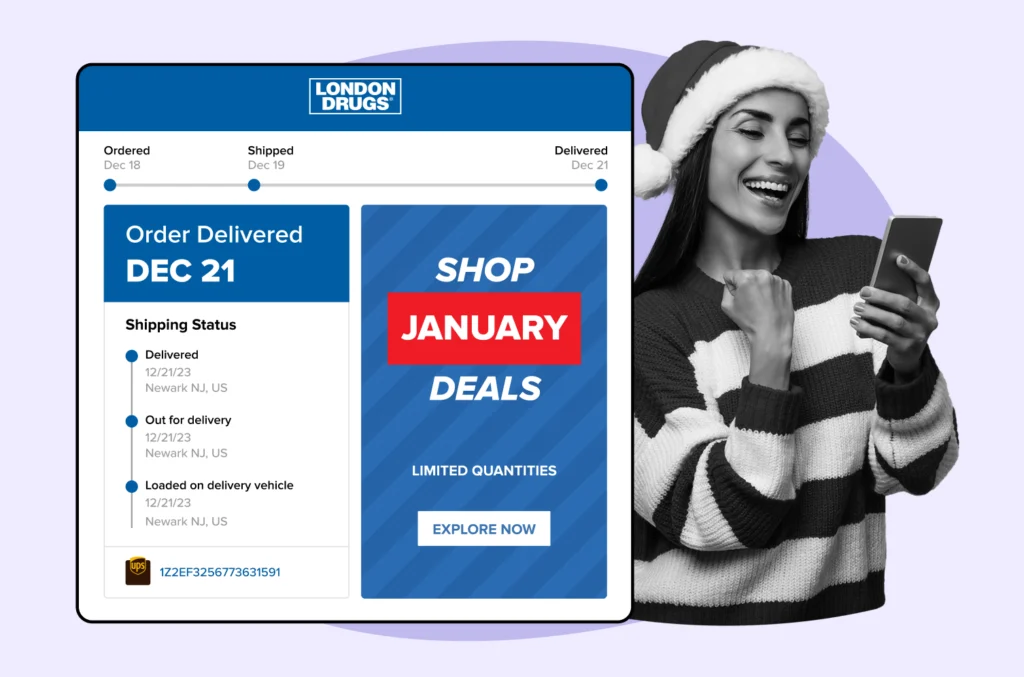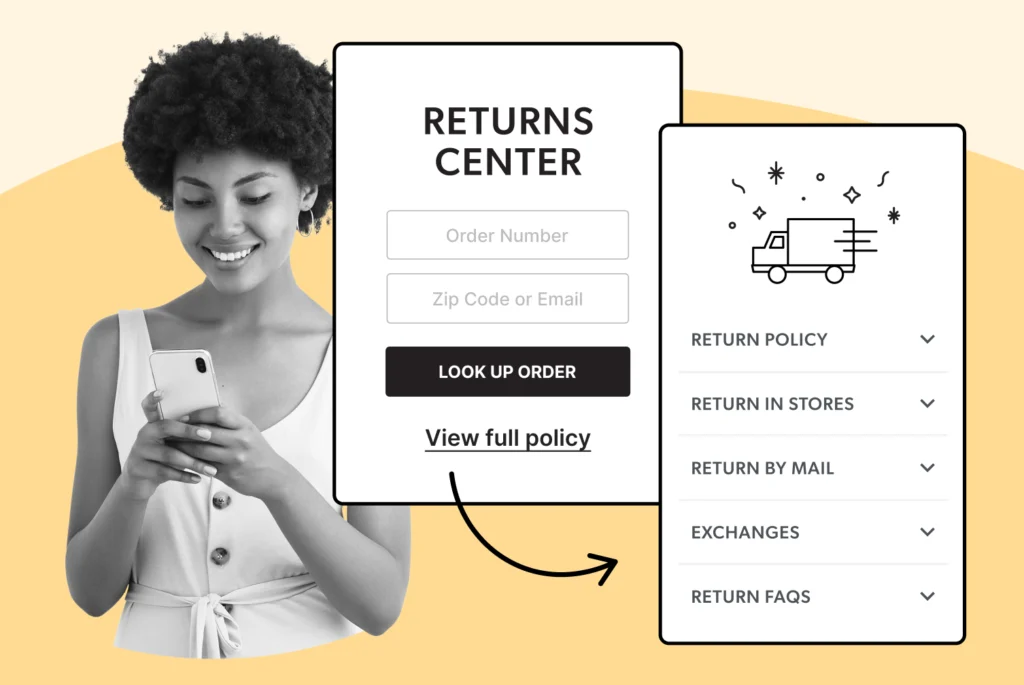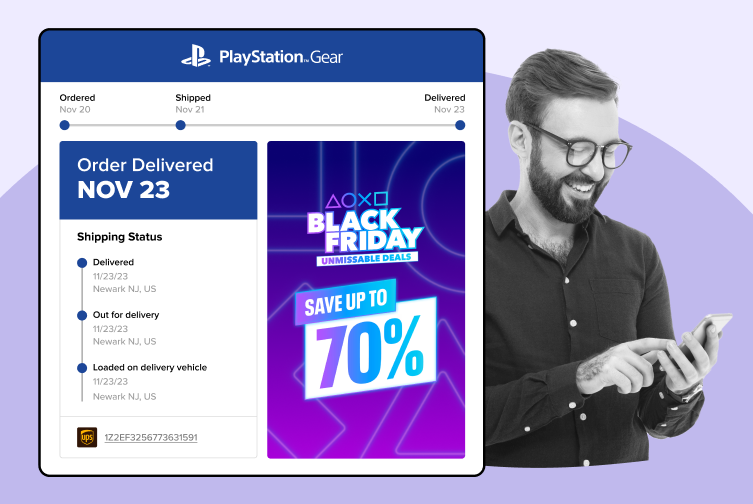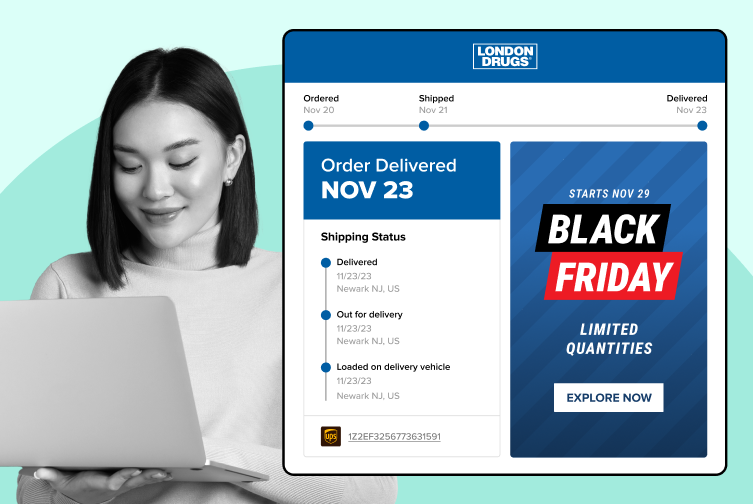
Holiday Shipping Deadlines 2025: How to Prepare
Streamline your returns management with our guide to mastering the enterprise RMA process. Enhance efficiency and reduce hassle.
Shipping, Tracking & Notifications
Boost customer experience and reduce support tickets
Realtime order and shipment tracking
Proactive order and shipping notifications
AI-Enhanced Discounted Labels
Predictive pre-purchase estimated delivery dates
Self-Serivce branded order tracking
Effortless experience delivered
Identify and Resolve Order Issues
Realtime order and shipment tracking
Make returns profitable and delight customers
Flexibility to define any return destinations & conditions
Simplify returns for your customers and team
Incentivize exchanges over returns
Returns management made easy for your team
Returns management made easy for your team
Easy claims and smart upsells
Understand why your customers are returning
In-Store & Curbside Pickup
Unify the online and the in-store experience
Hassle-free pickup experience for customers
In-Store dashboard to keep operations streamlined
In-Store and Online orders unified
Drive foot-traffic to your stores
Shipping, Tracking & Notifications
Boost customer experience and reduce support tickets
Realtime order and shipment tracking
Proactive order and shipping notifications
AI-Enhanced Discounted Labels
Predictive pre-purchase estimated delivery dates
Self-Serivce branded order tracking
Effortless experience delivered
Identify and Resolve Order Issues
Realtime order and shipment tracking
Make returns profitable and delight customers
Flexibility to define any return destinations & conditions
Simplify returns for your customers and team
Incentivize exchanges over returns
Returns management made easy for your team
Returns management made easy for your team
Understand why your customers are returning
In-Store & Curbside Pickup
Unify the online and the in-store experience
Hassle-free pickup experience for customers
In-Store Dashboard to keep operations streamlined
In-Store and Online orders unified
Drive foot-traffic to your stores
Boost customer experience and reduce support tickets
Realtime order and shipment tracking
Proactive order and shipping notifications
AI-Enhanced Discounted Labels
Predictive pre-purchase estimated delivery dates
Self-Serivce branded order tracking
Effortless experience delivered
Make returns profitable and delight customers
Flexibility to define any return destinations & conditions
Simplify returns for your customers and team
Incentivize exchanges over returns
Returns management made easy for your team
Equip your team for precise return checks.
Easy claims and smart upsells
Understand why your customers are returning
Unify the online and the in-store experience
Hassle-free pickup experience for customers
In-Store Dashboard to keep operations streamlined
In-Store and Online orders unified
Drive foot-traffic to your stores
Find the answer to all your questions
Take a step by step trip through our functionality to see how we can improve your ecommerce processes.
Explore the most comon questions about WeSupply
Calculate the ROI that WeSupply can bring you
Read actionable articles on how to optimize your post-purchase experience and decrease support tickets
Get inspired by stories of how our customers implemented an effortless post-purchase experience
Wondering if WeSupply is a good fit for you? Read through our use cases to see how we can help you increase conversion & improve CX!
A Deep Dive into Top Companies' Order Tracking & Returns Strategy
Find the answer to all your questions
Explore the most comon questions about WeSupply
Calculate the ROI that WeSupply can bring you
Request a no strings attached review of your current shopping experience and missed conversion opportunities
Take a step by step trip through our functionality to see how we can improve your ecommerce processes.
Read actionable articles on how to optimize your post-purchase experience and decrease support tickets
Get inspired by stories of how our customers implemented an effortless post-purchase experience
A Deep Dive into Top Companies' Order Tracking & Returns Strategy
Wondering if WeSupply is a good fit for you? Read through our use cases to see how we can help you increase conversion & improve CX!

The holidays bring a rush of orders, excitement, and busy warehouses. The holiday season is the busiest time for retailers, with increased sales and significant operational challenges. But once the wrapping paper is gone, another rush begins: post-holiday returns. For retailers and ecommerce stores, this period can be overwhelming. In fact, the National Retail Federation (NRF) reported that in 2023, holiday returns accounted for about 17.9% of total sales, totaling over $171 billion in merchandise. Gift exchanges and returns from gift recipients contribute significantly to the post-holiday surge, requiring flexible return policies to accommodate these unique situations.
If not handled well, returns eat into profits, slow down operations, and frustrate customers. But when managed correctly, they can strengthen customer trust, boost loyalty, and even generate new sales. Understanding consumers and their expectations during the returns process can improve satisfaction and encourage repeat business. Managing returns in 2025 is not just about minimizing losses, it’s about using smart strategies, technology, and customer-friendly practices to turn challenges into opportunities. A smooth, transparent return process can enhance brand loyalty and strengthen long-term customer relationships.
This guide will walk you through the best ways to handle post-holiday returns in 2025, from preparation before the holidays to using returns data for better planning in the future.
The best way to manage post-holiday returns is to prepare before the holidays even start. Once December ends, the volume of returns can spike overnight, and without a plan, it becomes stressful and costly.
One of the smartest steps is to set up returns management software. These tools let customers start returns online, generate prepaid labels, and track their return status. It reduces the workload for customer service and speeds up processing. According to Statista, 68% of online shoppers expect to manage their returns digitally, so software is no longer optional, it’s expected.
Staff preparation is just as important. Train your team to handle returns quickly and politely. During the holiday rush, you may even need seasonal staff to keep up with demand. For physical stores, set up a separate returns counter to avoid clogging checkout lines. Optimizing your warehouse layout is also crucial to efficiently handle high volumes of returns during the post-holiday period.
Finally, prepare your logistics. Work closely with carriers and warehouse partners to plan for increased reverse logistics. Extra space and manpower in your warehouse will make sure products move back into inventory fast. Review and improve your processes to boost operational efficiency and ensure a smooth returns experience.
A clear and fair returns policy sets the tone for how customers feel about your business. During the holidays, flexibility is key. Many people buy gifts weeks in advance, so a standard 30-day return policy may expire before the gift is even opened. Extending the window until mid or late January makes gift-giving less stressful for your customers. Flexible return policies can also help attract and retain new shoppers by making their first experience risk-free.
Your policy should also be easy to find and understand. Place it on product pages, in order confirmation emails, and inside packaging. Avoid complex wording. Customers want quick answers to questions like: “How long do I have to return this?” or “Do I need to pay for shipping?” In addition, providing detailed and accurate product descriptions can reduce returns and set proper expectations for shoppers.
Offering prepaid or QR-code-enabled labels is another win. Instead of making customers go through extra steps, provide what they need in the original shipment. Some businesses are also giving multiple return options, like drop-offs at UPS stores or lockers, in addition to mail-back and in-store returns.
At the same time, prevent abuse by setting limits. For example, require receipts, keep tags attached, or set rules for high-value items. Balancing customer friendliness with fraud prevention keeps your system fair and sustainable.
When returns are easy, customers are happier and more likely to shop with you again. When they’re hard, people leave and often share their frustration online.
In 2025, customers expect a self-service online portal where they can start a return in just a few clicks. This portal should allow them to print or download labels, select whether they want a refund or exchange, and track the process without waiting on hold.
Automation is a big help here. Some companies are using AI to scan returned items and decide quickly whether they can be resold, refurbished, or should be removed from stock. Automating returns processing can further speed up inspections, reduce manual effort, and improve customer satisfaction.
If you don’t have the resources to manage all of this in-house, partnering with a third-party logistics provider (3PL) can help. They specialize in handling returns at scale, ensuring items move through the system fast while you focus on sales and customer service. Additionally, having a knowledgeable support team ready to handle customer inquiries is crucial for ensuring a smooth returns experience.
Offering flexible return options is another must. Not all customers want to ship items back. Some prefer dropping them off at a store or third-party partner. Providing multiple options reduces friction and makes the process more convenient.
Handling returns and refunds is at the heart of effective post-holiday returns management. As the holiday season winds down and the post-holiday rush begins, ecommerce businesses and retailers face a surge in holiday returns. How you manage this process can make or break customer satisfaction, impact your bottom line, and shape the future of your customer relationships.
A customer-friendly returns policy is the foundation for hassle-free returns. Make sure your policy is clear, easy to find, and tailored to the unique challenges of post holiday returns. Offering store credit as an alternative to refunds is a smart strategy customers are more likely to make future purchases, helping you recover revenue that might otherwise be lost. Sweetening the deal with a discounted price on exchanged items or bonus store credit can further encourage exchanges over refunds, boosting customer loyalty and retention.
Returns management software is essential for streamlining the returns process, especially when handling high volumes after the holiday sales peak. These tools allow customers to initiate returns online, track their status, and receive automated updates, creating a seamless customer journey. For your business, this means faster processing returns, better inventory control, and valuable returns data to inform future decisions.
Inventory management and reverse logistics are critical during the post-holiday surge. Efficiently moving returned merchandise from customers back into your warehouse ensures that restocking items happens quickly, minimizing losses and keeping your supply chain running smoothly. Offering free return shipping can be a powerful incentive for customers to initiate returns, while also demonstrating your commitment to customer satisfaction.
Your customer service team plays a pivotal role in handling returns and refunds. Well-trained staff can answer questions, resolve issues, and provide multiple return options such as in-store, mail-in, or third-party drop-off locations to accommodate different customer preferences. This flexibility not only improves the customer experience but also helps reduce future returns by addressing customer needs promptly and effectively.
Returns aren’t just about customer service. They also affect your inventory and costs. When items come back after the holidays, you need a plan for what happens next.
First, inspect and categorize items quickly:
Resellable: Products in perfect condition can go straight back into inventory.
Refurbishable: Items with small issues, like damaged packaging, can be repaired, cleaned, or repackaged. These can be sold at a discount as “open-box.”
Unsellable: Products that are broken, used, or out of season. These can be liquidated, donated, or recycled.
As part of the exchange process, consider offering customers alternative products. This strategy can turn returns into new sales opportunities by cross-selling or upselling items that may better suit their needs.
Moving fast is key. The longer products sit in return piles, the harder it is to resell them. Conducting an inventory audit after the return season helps ensure stock levels are accurate and ready for upcoming sales. Monitoring return rates during this period can help you identify trends and improve inventory planning for future seasons.
Reverse logistics the process of moving goods from customers back to warehouses should also be optimized. Partnering with carriers that handle large volumes of returns efficiently keeps costs under control and improves turnaround times.
Returns can feel stressful for customers, especially during the busy holiday season. Clear and consistent communication makes the process smoother. Proactive updates and transparency help keep customers happy during the returns process.
Automated notifications are a simple way to build trust. Send updates when the return is received, processed, and when the refund or exchange is on its way. This reassurance reduces the number of “Where’s my refund?” inquiries.
Encouraging exchanges instead of refunds can also protect your revenue. You can offer free shipping for exchanges or give store credit bonuses to make the option more appealing. For example, instead of refunding $50, offer $55 in store credit. Many customers will take the extra value.
Customer support teams need to be ready too. Offer multiple channels like chat, email, and phone so customers can reach you in the way they prefer. Train staff to handle returns with empathy and efficiency. A polite and helpful interaction during a return can turn a frustrated customer into a loyal one. Excellent support during returns can drive customer retention and encourage repeat business.
Every return tells a story, and the patterns can guide smarter business decisions.
Track the main reasons for returns: Was it sizing? Poor product quality? Misleading descriptions? By analyzing this data, you can make changes that reduce future returns. For instance, if many returns are due to sizing issues, add better size guides or use customer reviews to highlight fit details. Using this information enables you to make informed decisions on inventory management, product offerings, and customer service improvements.
Data also helps with forecasting. If you know certain products are returned more often, you can adjust your stock levels or rethink your buying strategy. Retailers that use data analytics are better equipped to handle demand shifts, saving money in the long run.
Key metrics to monitor include:
Return rate by product or category
Average refund turnaround time
Customer satisfaction scores
Rate of fraudulent returns
When used correctly, return data not only improves your operations but also helps build stronger relationships with customers by addressing their concerns directly. Additionally, you can leverage returns insights to develop targeted marketing strategies that enhance customer experience and foster loyalty.
Return fraud is a growing issue for retailers. The NRF estimated that in 2023, $101 billion in returned merchandise was linked to fraud or abuse.
Common types include wardrobing (wearing an item once before returning it), returning stolen goods, or switching product tags. Without clear policies and enforcement, these practices cut into profits.
To protect your business, require proof of purchase for all returns, whether digital receipts or order confirmations. Set stricter rules for high-value products, such as electronics or luxury items. Use data to flag suspicious patterns, like customers who return too many high-value items in a short time.
The key is to enforce policies fairly, without making honest customers feel distrusted. Communicate rules clearly in your return policy, so expectations are set upfront.
Protect your business with smarter fraud prevention
Book a quick call with our experts to see how WeSupply helps you enforce clear return policies, require proof of purchase, and use data to spot suspicious patterns, reducing fraud while keeping the process fair for honest customers.
Returns have a hidden cost: their impact on the environment. Shipping items back and forth increases carbon emissions, and unsellable goods often end up in landfills. In 2023, Optoro estimated that 9.5 billion pounds of returned goods went to landfills in the U.S. alone.
In 2025, customers care about sustainability, and retailers can stand out by offering eco-friendly return options. Use reusable or recyclable packaging where possible. Partner with recycling or donation programs to handle unsellable items responsibly.
On the cost side, monitor expenses closely. Categorize returns by type (fraudulent, refurbishable, etc.) to see where money is lost. Use forecasting tools to budget for post-holiday return surges. Some businesses even offer loyalty rewards or discounts for customers who keep items, reducing unnecessary returns.
Behind every smooth return process is a well-trained team. Employees need clear instructions and ongoing support to handle returns quickly and professionally.
Training should cover everything from how to process returns in your system to how to speak with upset customers. Role-playing customer interactions can prepare staff for real situations.
Keep training ongoing, not just seasonal. As policies, technologies, and customer expectations evolve, your team should stay updated. Encourage employees to share feedback from their experiences often, front-line staff see issues before managers do.
You can’t improve what you don’t measure. After the post-holiday rush, evaluate your performance.
Track KPIs such as:
Return rate: What percentage of holiday sales came back?
Refund turnaround time: How fast did customers receive their money or exchanges?
Customer satisfaction: Did returns lead to complaints or repeat sales?
Operational costs: How much did processing returns cost compared to sales?
Customer feedback is another valuable source. Simple surveys after a return can reveal pain points. For example, if many customers complain about refund delays, you know where to focus improvements.
Continuous improvement means treating returns as a learning tool, not just an expense. Each season, use what you learned to refine policies, update systems, and train staff better.
Post-holiday returns are not going away. In fact, as ecommerce grows, returns are expected to rise alongside it. Planning for the future is key to staying ahead.
Adopt new technologies like AI-powered inspections, virtual try-ons to reduce sizing mistakes, or predictive analytics for better forecasting. Stay flexible with policies, adjusting them each year based on data.
Most importantly, treat returns as part of the customer journey. A smooth return process can create trust, leading customers to shop with you again and again.
Handling post-holiday returns in 2025 doesn’t need to drain your team or upset your customers. WeSupply makes it easy to turn returns into a smooth process that saves time, protects profits, and improves customer loyalty. Here’s how WeSupply helps:
Self-service returns, 24/7 – Customers can start a return anytime without calling or emailing support, giving them control and saving your team hours.
Automated approvals and return rules – Set clear guidelines for what gets approved automatically and when a manual check is needed, reducing risk for high-value items.
Automatic return labels and QR codes – Generate labels instantly or offer printer-free QR codes at over 200,000 drop-off locations, making returns simple and eco-friendly.
Proactive notifications and real-time tracking – Keep customers updated with email and SMS alerts, so they never have to ask, “Where’s my return?”
Fraud detection and blocklists – Spot serial returners or policy abusers, block them automatically, and sync your blocklist to prevent future losses.
Collect images and feedback – Customers can upload photos and notes during the return, reducing back-and-forth emails and giving you better insights.
Smart return rules and flexible policies – Create outcomes for every situation, from final sale items to holiday-only return windows, and send items to the right destination.
Automatic fee calculation – Apply restocking or repackaging fees automatically, removing guesswork and reducing human error.
Faster inventory restocks – Warehouse teams can inspect returns with clear quality check criteria and add notes, helping resell items sooner.
Partial refunds – Refund items as they arrive instead of waiting for the full order, keeping customers satisfied while maintaining accuracy.
Instant store credit and exchanges – Encourage customers to choose credit or exchanges instead of refunds, boosting profitability by up to 95%.
Branded returns portal – Replace confusing courier pages with a custom portal that matches your brand, improving trust and loyalty.
Team collaboration tools – Customer support and warehouse staff can see the same activity logs, comments, and updates, making problem-solving faster.
Search and filter dashboard – Find return requests instantly by ID, name, SKU, or tracking number, so no return is ever missed.
Barcode scanner integration – Scan returns as they arrive in the warehouse to update status quickly and accurately.
Enterprise-ready solutions – Handle complex returns across multiple warehouses and stores, backed by SOC 2 Type II security and seamless integrations.
Analytics and reporting – See which items are returned most, why customers are sending them back, and who your serial returners are, so you can lower your return rate.
Intelligent dispositions – Route returns to the closest warehouse, vendor, recycling center, or donation facility, cutting costs and speeding up refunds.
Warranty and shipping protection
Manage claims, recalls, and shipping protection to safeguard revenue and build customer trust.
With WeSupply, post-holiday returns turn from a cost burden into a growth opportunity. You save time, reduce fraud, recover lost revenue, and deliver a return experience customers appreciate.
Book a quick call with our experts to see how WeSupply helps you simplify holiday shipping while keeping customers happy.
Managing post-holiday returns in 2025 requires clear policies, proactive communication, and the right technology.
WeSupply helps you simplify the process with branded self-service return portals, automated return labels, real-time notifications, and flexible exchanges. By giving customers control and reducing manual work for your team, you cut costs while improving satisfaction. Returns become less of a burden and more of an opportunity to protect revenue and build loyalty.
Businesses that invest in smarter returns management with tools like WeSupply position themselves to keep customers happy, protect margins, and turn seasonal challenges into long-term growth.
Returns Analytics for eCommerce Business
Book a quick call with our experts to see how WeSupply can help you understand why your customers are returning: Identify the most returned products, Understand why those products are returned, Identify which customers are serial returners, Reduce Return Rate with Actionable Insights, Returns data available in BigQuery.
1. Why are post-holiday returns important for retailers in 2025?
Post-holiday returns can impact profits and customer loyalty. In 2023, 17.9% of holiday sales were returned, totaling $171 billion. Managing them well builds trust, keeps margins healthy, and improves repeat business.
2. How can retailers prepare for post-holiday returns?
Plan ahead with trained staff, flexible return policies, and warehouse space. Use returns management software to reduce customer service strain and speed up processing.
3. What makes a returns policy customer-friendly during the holidays?
Extend return windows into January, provide prepaid labels or QR codes, and offer multiple return options like mail, store, or drop-off locations. Keep the language clear and easy to find.
4. How does WeSupply simplify post-holiday returns?
WeSupply offers branded self-service portals, automatic labels, real-time tracking, and flexible exchanges. This reduces manual work for your team and keeps customers satisfied with a smooth, transparent return process.
5. Can WeSupply help prevent return fraud?
Yes. WeSupply detects serial returners, blocks policy abusers, and applies smart return rules. Fraud prevention tools protect your margins while ensuring genuine customers enjoy a smooth return experience.
6. Does WeSupply improve revenue recovery from returns?
WeSupply encourages exchanges and instant store credit instead of refunds. Retailers can recover up to 95% of lost revenue while keeping customers engaged with the brand.
7. Does WeSupply have an Official Shopify App?
Yes. WeSupply has an Official Shopify App. You can download it and start integrating with your Shopify Store.
8. Does WeSupply have an official Magento extension?
Yes, WeSupply has an official extension for Magento. The WeSupply x Magento integration allows for automating order tracking experiences, reducing customer inquiries, automating shipping email and SMS notifications, and providing a fully branded order tracking experience
9. Does WeSupply have an official BigCommerce App?
Yes, WeSupply has an official BigCommerce App. You can integrate WeSupply with your BigCommerce store to improve your post-purchase customer experience.
Learn How To Create Successful Post Purchase Email Campaigns
Build an effective post-purchase email flow that helps you increase customer satisfaction and drive revenue growth!
Negotiate better terms with suppliers. Partnering with reliable suppliers and carriers creates leverage in negotiations. For example, committing to steady shipping volume can lead to lower rates or priority service by securing discounts based on quantities shipped.

Streamline your returns management with our guide to mastering the enterprise RMA process. Enhance efficiency and reduce hassle.

Discover effective strategies for managing returns in retail. Enhance customer satisfaction while minimizing costs. Read the article for practical insights.

Discover essential strategies to streamline bulk returns handling and enhance efficiency. Read the article for practical tips!

Discover proven best practices for designing an enterprise ecommerce returns policy that boosts customer satisfaction and long-term success.

Discover effective strategies for managing returns in retail. Enhance customer satisfaction while minimizing costs. Read the article for practical insights.

Learn effective strategies for handling shipping exceptions and keeping customers informed. Enhance your shipping process today!

Discover practical strategies to reduce shipping costs for your business. Boost your bottom line without sacrificing service. Read the article now!

Boost your average order value with effective upselling strategies post-purchase. Discover practical tips to enhance customer satisfaction. Read more!

Discover effective strategies to enhance ecommerce revenue retention and foster customer loyalty. Read the article to elevate your business success.